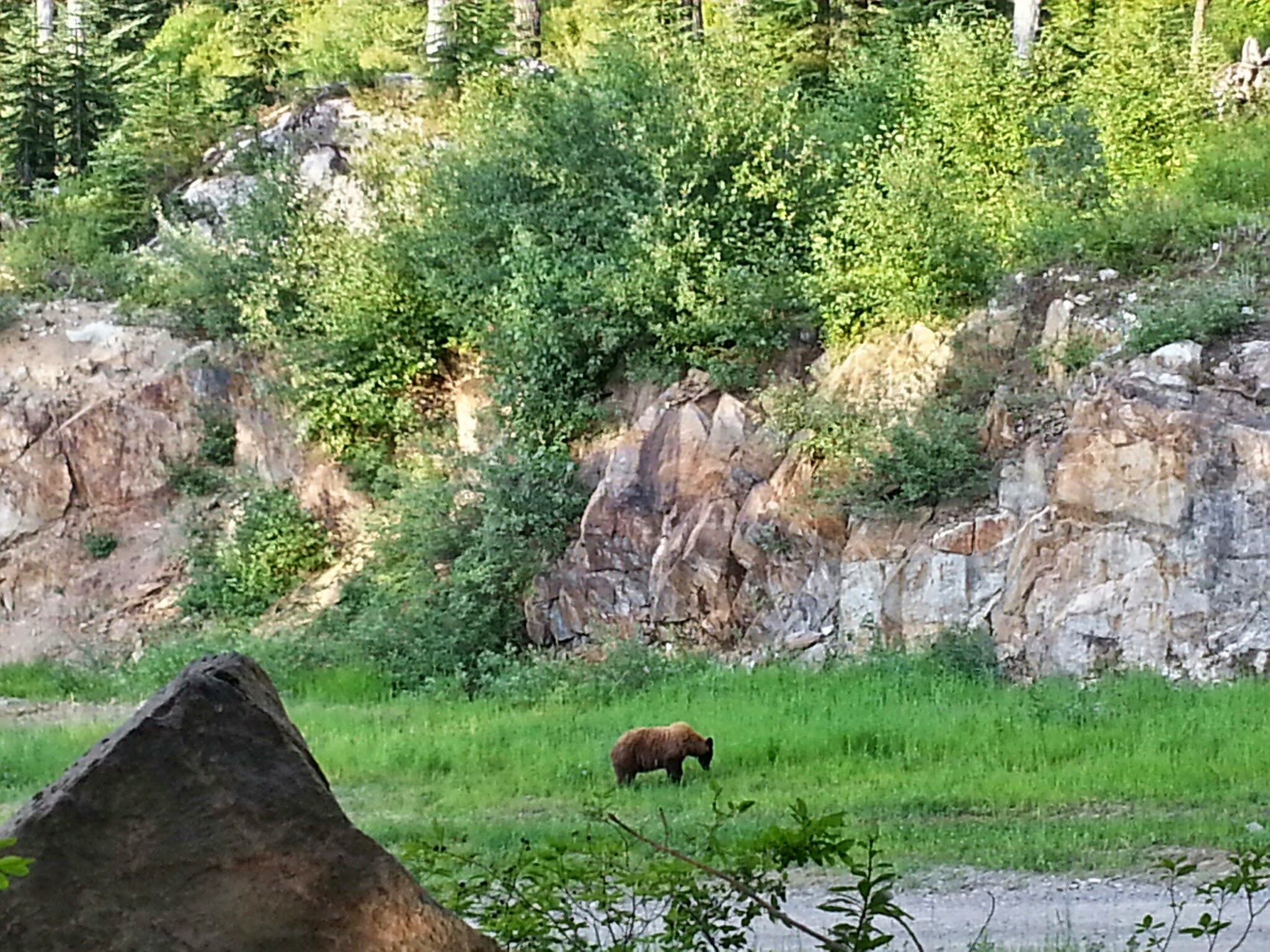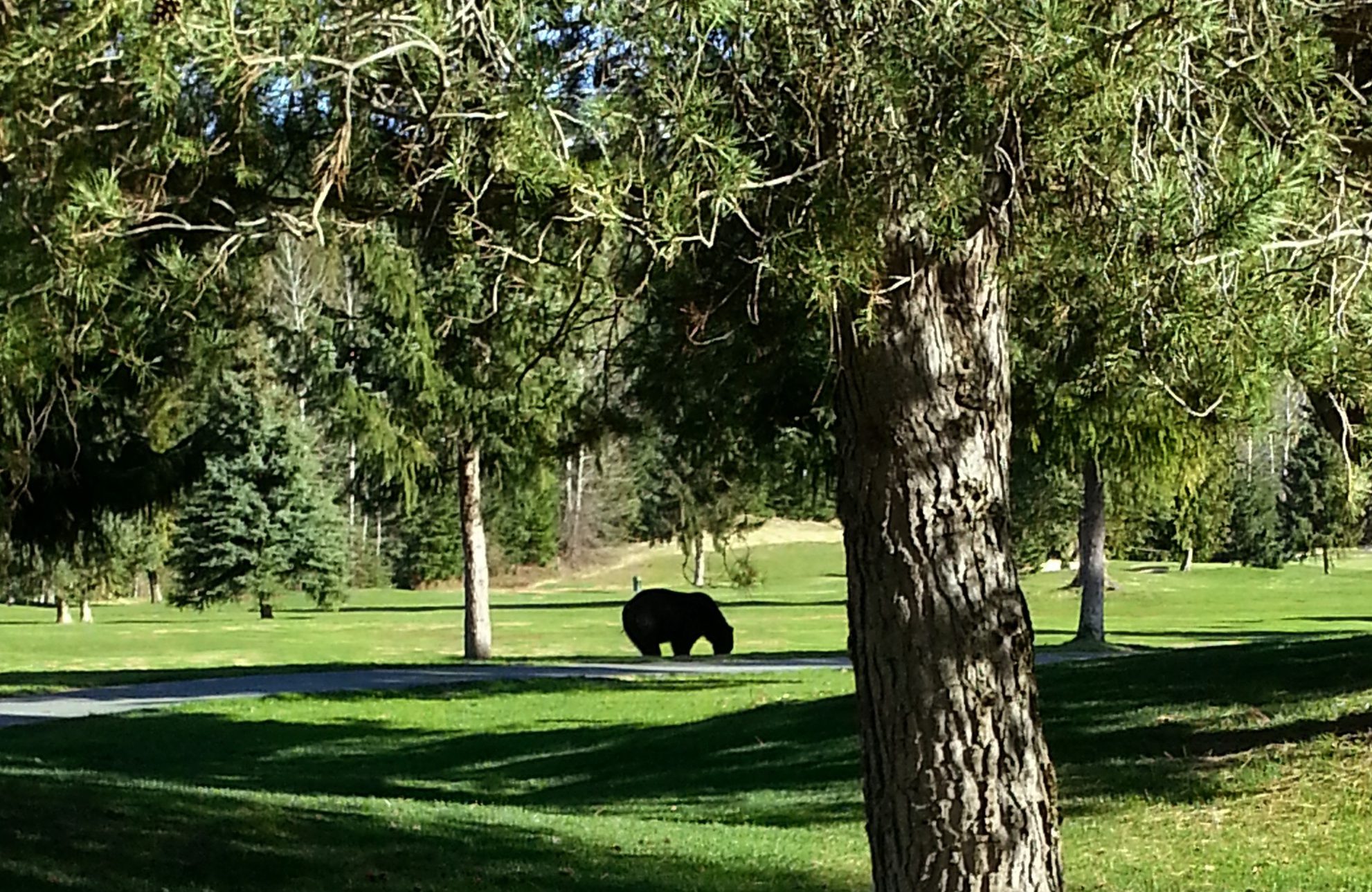Whistler Bear Smart Vacation Rentals by Owner

Whistler is Bear Country. And with a standing population of around 50 bears in the local area, it is critical for those visiting Whistler to get clued up on bear awareness and safety.
Read on to find out about the types of bear found in Whistler and how to minimize bear-human conflict.
Species of bear in Whistler
Although there have been very rare cases of grizzly bears being spotted in the Sea to Sky area, Whistler is home only to black bears. Despite their name, black bears can come in all colors, from the white Kermode bear, to all shades of brown (cinnamon bears) as well as their namesake black. Some visitors encounter lighter colored bears and will mistakenly identify them as brown bears or grizzly bears – but there are some differences.
Test your knowledge of bear species with this test from Montana Fish, Wildlife, & Parks.

A (brown colored) black bear on one of Whistler’s ski runs.
Bears can be seen in Whistler from April to November, depending on the yearly temperatures and snow. In early summer they are most likely to be found on the valley floor before they move up into the mountains for the berry season. The Whistler Golf course is a popular bear hangout, especially in early mornings and just before sunset.
The Bears of the Whistler Golf Club – Video from WhistlerGolfClub
How to be Bear Smart
The Bear Smart Whistler Visitor’s Guide gives 4 basic guidelines:
- Never feed a bear. This means intentionally OR unintentionally. Bears are attracted to human food as it is high in calories and easier to procure than picking berries or catching salmon. Bears that are accustomed to easily accessible human food, either from being fed or through raiding garbage, lose their wariness of humans and go to greater lengths to get their food. This can include breaking into people’s homes or cars, which results in the bear being killed. It’s the law in Whistler to dispose of all garbage in bear-proof containers.
- Give bears space. Never approach a bear, especially to pet them or for a better photo. It is recommended to keep a distance of at least 100 m (or about the length of 7 school buses) between you and the bear. Bears usually do their best to avoid people and it’s not a good idea to force them into an uncomfortable position.
- Watch out on the roads. It is not uncommon to see bears grazing on the side of the road on the Sea to Sky highway between Squamish and Whistler. Don’t stop on the highway to take photos and keep your eyes open for bears crossing the highway – unfortunately many are injured or killed by being hit by cars.
- Stay alert and aware. When out hiking in the mountains or biking through the trails, stay alert to the possibility of encountering a bear. Your goal is to avoid surprising a bear, so make your presence known by talking, singing or calling out every now and again. You can carry a bear bell attached to your backpack to warn bears of your approach. My go-to method is playing music through the speaker on my phone. If hiking with dogs, keep them on a leash or close to you, as they can often provoke bears more than the presence of humans.
What to do when you encounter a bear
If you see a bear in human territory, you should phone the BC Conservation Officer Service (COS) at 1-877-952-7277 or 604-905-BEAR.
It’s important to make this call so that COS can act to remove the bear from any potential conflict with humans, steering it clear of homes, garbages etc so the bear does not become used to hanging around humans. The more accustomed bears become to people, the harder it is to change their behavior. Most of Whistler’s bear deaths take place because the bears are no longer wary of humans.

A black bear on the Whistler Golf course.
If you encounter a bear in Whistler, Bear Smart recommends the following course of action.
Stop and assess.
- Remain calm and do not approach the bear. In most cases, the bear will flee.
- If the bear is still a distance away, turn back and return the way you came. If you must pass, keep your distance and give the bear a wide berth.
If you come across a black bear suddenly at close range.
- This can happen when moving fast through the bike trails. Stand your ground and face the bear.
- Identify yourself as human by talking in a calm tone of voice while backing away slowly.
- Never run.
If a black bear approaches you.
- It’s natural to be frightened, but don’t panic.
- If you meet a bear in the woods, or in its territory, talk in a calm and respectful tone to let the bear know you are not threatening (particularly if the bear is defending cubs or a food cache).
- If you encounter a bear in an urban area or human territory, use a loud, firm voice as though you are speaking to a dog that’s misbehaving. Say “No!” and repeat as necessary. Remove your sunglasses and make direct eye contact with the bear.
- Sometimes a bear may try to motivate you to leave, through intimidation. It may “pop” its jaws or swat the ground while blowing or snorting. It may lunge toward you or “bluff” charge – run toward you and then suddenly stop and turn away. Although scary, you are not likely to be hurt. For your own safety, stand your ground until the bear turns away and then retreat.
- You can carry bear spray as a precaution and use it if a black bear is persistent in approaching you or attacks.
- If a black bear attacks you offensively making full physical contact, fight back with any weapon you can find, including rocks and branches. Do NOT play dead.
Whistler’s black bears are generally timid creatures that are tolerant of humans and human activity. Spotting a black bear is an exhilarating experience and can really enhance your trip to Whistler. Keep these tips in mind during your visit to have a happy and safe Whistler vacation!
Bear viewing optional… from your Whistler vacation rental by owner balcony.
June 7, 2016
Comments
Leave a Reply
You must be logged in to post a comment.

 Katharine Mills is a trail and ultra runner living in North Vancouver. Originally from the UK, she lived in Whistler for two years before making the move to the city. Compared to the UK, she thinks Canada has an incredible lifestyle, but terrible tea. Her favourite things are exploring the wilds of the BC backcountry, racing mountain bikers down the trails of North Vancouver, and Honey’s Doughnuts from Deep Cove.
Katharine Mills is a trail and ultra runner living in North Vancouver. Originally from the UK, she lived in Whistler for two years before making the move to the city. Compared to the UK, she thinks Canada has an incredible lifestyle, but terrible tea. Her favourite things are exploring the wilds of the BC backcountry, racing mountain bikers down the trails of North Vancouver, and Honey’s Doughnuts from Deep Cove.